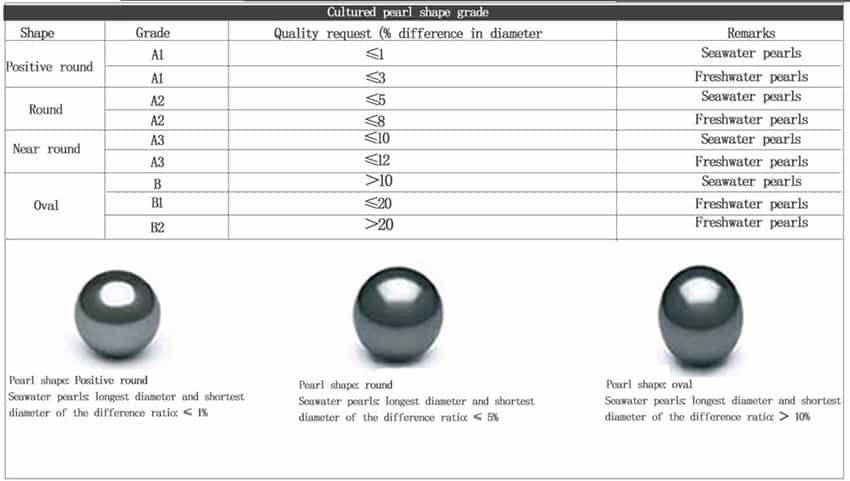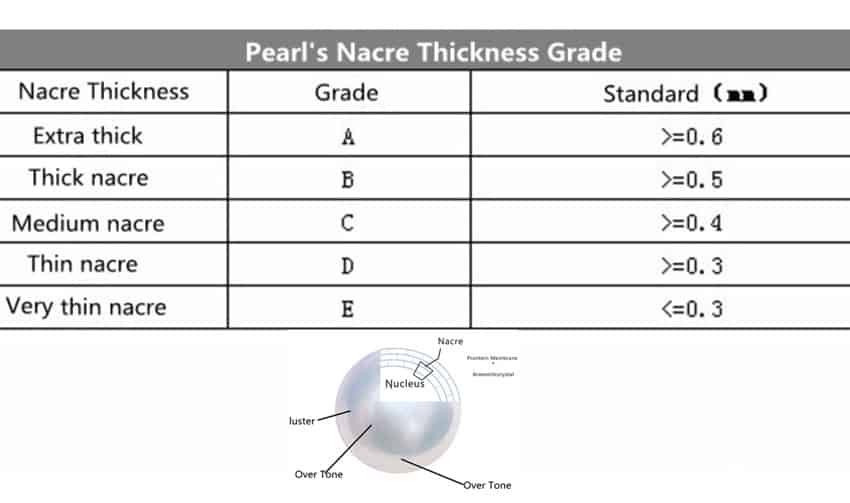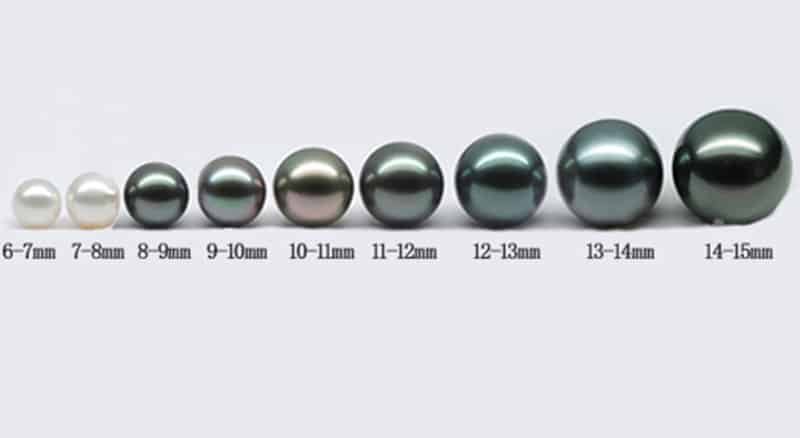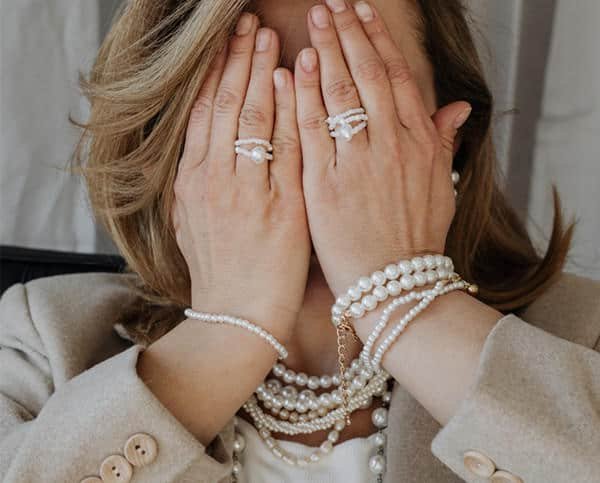Pearls are commonly classified into different quality grades based on their appearance, shape, size, luster, surface quality, and nacre thickness. The following are the most commonly used quality grade classifications for pearls:
General quality grade classifications
AAA: This is the highest quality grade for pearls. They are round or near-round with an excellent luster and a clean surface. The nacre thickness is thick, which makes the pearls durable and long-lasting.
AA: This quality grade is slightly lower than AAA. The pearls are still round or near-round with a good luster, but may have slight imperfections on their surface. The nacre thickness is slightly thinner than AAA.
A: This quality grade is the most common for freshwater pearls. The pearls are usually off-round with a fair to good luster. The surface may have noticeable imperfections, but the nacre thickness is still thick enough to make the pearls durable.
B: This quality grade is lower than A. The pearls may have an irregular shape with a poor luster and noticeable imperfections on the surface. The nacre thickness is thinner, which makes the pearls less durable.
C: This is the lowest quality grade for pearls. The pearls have an irregular shape with a very poor luster and numerous noticeable imperfections on the surface. The nacre thickness is very thin, which makes the pearls less durable.
Let’s delve into the detailed aspects of a pearl’s appearance: luster, shape, surface quality, nacre thickness, size, and color.
The Luster of Pearl

According to GIA, luster is the most important of the seven factors that determine the value of a pearl, and luster is the soul of a pearl. Luster gives pearls their unique beauty. The luster of pearls is due to the reflection of light on the surface of the pearl layer, which has many calcium carbonate formations. When a person faces a light source, such as a window, doorway, etc., and places the pearl in front of him or her, and looks at it against the light, a good pearl can be seen to emit a colorful iridescence, with rich and varied layers, and can be seen to have a metallic spherical surface, even reflecting the pupil of a person, which is particularly bright and can be included in the A grade, and to a lesser extent in the B grade. The luster of seawater pearls is brighter than that of freshwater pearls.
The luster of a pearl is an important factor in determining its quality. There are several aspects to consider when grading the luster of a pearl:
High luster
This is one of the highest quality pearls, with a surface that reflects light very brightly, giving off a glowing, radiant appearance. The light appears to come from within the pearl, giving it a healthy and lively appearance.
Medium luster
Pearls with medium luster have a slightly less bright surface than those with high luster, but still have a good amount of brightness and glow. The surface may have slight irregularities, but overall the pearl looks very beautiful.
Low luster
Pearls with low luster have a dull, lackluster appearance, with little to no reflective shine. This can be due to a variety of factors, including thin or uneven nacre layers, damage to the surface of the pearl, or poor quality of the original nucleus used to grow the pearl.
The Shape of Pearl

There are eight basic shapes of pearls: round, nearly round, button, teardrop, pear, oval, baroque and flat. “The more round the pearl, the more beautiful it is, and this is the aesthetic habit of the majority of people. When combined with luster, they create a hazy mood. The percentage difference between the longest diameter and the shortest diameter of the pearl is ≤ 1% for the standard of positive roundness, 1%-5% for the standard of roundness, and between 5% and 10% for the standard of near roundness. In general, one can see the roundness with one’s own eyes, and perfectly round pearls are the most prized, although there are exceptions, as aesthetics continue to individualize differences, well formed pear-shaped, oval or baroque cultured pearls are also prized by pearl lovers. In addition, since seawater pearls are nucleated and have a better shape, they are generally better rounded than freshwater pearls of the same grade.
The shape of a pearl is another important factor to consider when evaluating its quality. The following are some common pearl shapes:
Round
Round pearls are the most sought-after shape, and are typically the most valuable. They are perfectly spherical in shape, with a smooth and uniform surface.
Near-round
Near-round pearls are slightly asymmetrical, but still appear mostly round to the naked eye. They are often less expensive than perfectly round pearls.
Oval
Oval pearls are elongated in shape, and may be slightly flattened or asymmetrical. They are often used in jewelry designs where a more unique shape is desired.
Button
Button pearls are flattened on one side and round on the other, resembling a button. They are often used in stud earrings or other jewelry designs where a low profile is desired.
Baroque
Baroque pearls are irregular in shape, and can vary greatly in size and color. They are often used in more artistic or avant-garde jewelry designs.
When evaluating the shape of a pearl, it is important to look for symmetry, uniformity, and a smooth surface. Round pearls are generally the most valuable, followed by near-round and oval shapes. Button and baroque pearls are often less expensive, but can still be beautiful and unique.
The Surface Quality of Pearl

GIA evaluates the number of surface imperfections on a pearl to judge quality, and if the surface characteristics are numerous or very pronounced, they can affect the pearl’s solidity and severely reduce its value. If the surface characteristics are inconspicuous, or extremely subtle and can be concealed by drilling or setting, you will have less impact on the appearance and value of the pearl. The fewer the threads, spots, marks, pits and dots on the surface of the pearl, the better the quality, and it is generally an acceptable standard to not see defects from 0.5 meters away.
The cleanliness of a pearl’s surface is another important factor in determining its quality. The following are some common factors to consider when grading the cleanliness of a pearl:
Clean surface
A pearl with a clean surface has no visible blemishes or imperfections on the surface. This is the highest quality pearl surface.
Lightly spotted surface
A pearl with a lightly spotted surface may have some small, barely visible blemishes or imperfections, but they do not detract from the overall beauty of the pearl.
Moderately spotted surface
A pearl with a moderately spotted surface may have more noticeable blemishes or imperfections, but they are still not severe enough to greatly affect the beauty of the pearl.
Heavily spotted surface
A pearl with a heavily spotted surface has numerous visible blemishes or imperfections, which significantly detract from the overall beauty of the pearl.
When evaluating the cleanliness of a pearl’s surface, it is important to examine the surface under good lighting and to look for any visible imperfections or blemishes. A clean surface is generally the most valuable, followed by lightly spotted and moderately spotted surfaces. Heavily spotted surfaces are generally considered to be lower quality, and may be less valuable as a result.
The Thickness of Pearl

The thickness of a pearl’s nacre is an important factor in determining its quality. Nacre is the substance that forms the pearl’s layers and gives it its lustrous appearance. The following are some common factors to consider when grading the thickness of a pearl’s nacre:
Thick nacre
A pearl with a thick nacre layer is generally considered to be of higher quality. This is because a thick nacre layer provides better protection for the pearl, and can help to ensure that the pearl retains its luster and beauty over time.
Medium nacre
A pearl with a medium nacre layer is still considered to be of good quality, but may not be as valuable as a pearl with a thick nacre layer.
Thin nacre
A pearl with a thin nacre layer may be considered lower quality, as it is more susceptible to damage and may not retain its luster and beauty over time.
When evaluating the thickness of a pearl’s nacre, it is important to examine the pearl under good lighting and to look for any visible signs of wear or damage. A thick nacre layer is generally the most valuable, followed by medium thickness. Thin nacre layers may be less valuable and may not be as durable over time.
The Size of Pearl

The diameter of common pearls on the market today ranges from 2mm to 16mm, generally speaking, the larger the pearl, the rarer the quantity, and the price tends to increase exponentially.
The size of a pearl is another important factor in determining its quality. The following are some common factors to consider when grading the size of a pearl:
Large size
A pearl that is larger in size is generally considered to be of higher quality, as larger pearls are more rare and difficult to produce.
Medium size
A pearl that is medium in size is still considered to be of good quality, but may not be as valuable as a larger pearl.
Small size
A pearl that is smaller in size may be considered lower quality, as it is more common and less valuable than larger pearls.
When evaluating the size of a pearl, it is important to consider the overall size of the pearl as well as its size relative to other pearls of the same type. Larger pearls are generally more valuable, but it is also important to consider other factors such as luster, surface quality, and color.
The Color of Pearl

The color of a pearl is an important factor in determining its quality. Pearls can come in a wide range of colors, from white and cream to pink, silver, and even black. The following are some common factors to consider when grading the color of a pearl:
White or Cream Pearl
White or cream-colored pearls are generally considered to be of higher quality, as they are more rare and difficult to produce. White pearls are formed within a variety of oysters, including Akoya, Freshwater, and South Sea oysters. These oysters create pearls in a range of colors, but it is the classic white pearls that have become synonymous with elegance and sophistication. The formation of white pearls is a testament to the remarkable processes of nature.
Purple Pearl
Purple pearls, also known as lavender pearls or violet pearls, are primarily cultivated in the saltwater regions of French Polynesia and the Sea of Cortez. These pearls are formed within the Pinctada margaritifera and Pinctada mazatlanica oysters, respectively. The rich and enchanting hues of purple pearls are a result of the mollusks’ interaction with their environment and the deposition of colorful pigments.
Pink Pearl
Pearls with a pink hue are also highly valued, especially if the color is consistent throughout the pearl. Pink pearls are formed within a variety of oysters, including the Akoya, Freshwater, and South Sea oysters. These remarkable gems owe their stunning pink color to a combination of factors, such as the presence of certain pigments in the oyster’s mantle and the specific environment in which they are cultivated.
Black Pearl
Black pearls are highly valued for their rarity and unique beauty. Black pearls, also known as Tahitian pearls, are primarily cultivated in the pristine waters of French Polynesia, specifically around the islands of Tahiti. These pearls are formed within the Pinctada margaritifera oyster, a species native to the region. The deep, dark color of black pearls is a testament to the mesmerizing forces of nature.
Peacock Green Pearl
Peacock Green pearls, also known as Tahitian pearls, are primarily cultivated in the pristine waters of French Polynesia, specifically the islands of Tahiti. These pearls are the result of the Pinctada margaritifera oyster, which thrives in the warm, tropical lagoons of the region. It is within these oysters that the magic of the Peacock Green pearl begins to unfold.
Golden or yellow Pearl
Pearls with a golden or yellow hue can be of high quality, but may be less valuable than white or cream-colored pearls. Golden pearls, also known as South Sea pearls, are cultivated primarily in the warm and pristine waters of the South Pacific. They are formed within the Pinctada maxima oyster, which thrives in the depths of the ocean. These oysters produce pearls of remarkable beauty, radiating the warm glow of gold.
Silver Pearl
Pearls with a silver hue are relatively rare and can be highly valued. Silver pearls, also known as Akoya pearls, are primarily cultivated in the saltwater oysters of Japan, China, and Vietnam. These pearls are renowned for their lustrous silver color, which sets them apart in the world of pearls. The meticulous cultivation and nurturing of these oysters contribute to the creation of these exquisite gems.
When evaluating the color of a pearl, it is important to consider the overall hue, as well as any secondary or overtone colors that may be present. Pearls with a consistent color throughout are generally considered to be of higher quality than pearls with multiple colors or uneven color distribution.
It’s important to note that the quality of pearls can vary based on a number of factors, including the type of pearl, its origin, and its size. Ultimately, the best way to determine the quality of a pearl is to evaluate it in person or to purchase from a reputable and trustworthy seller.









